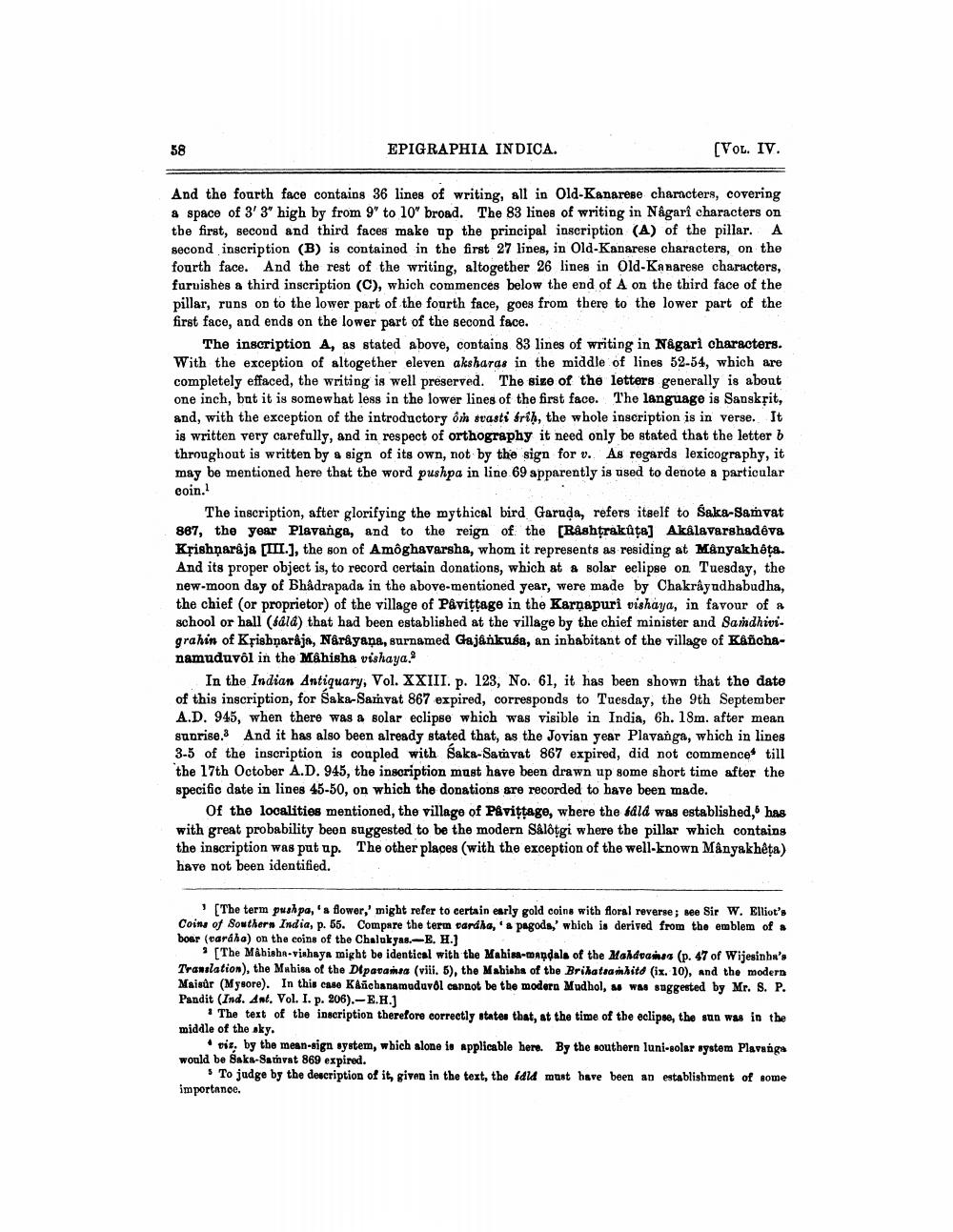________________
58
EPIGRAPHIA INDICA.
(Vol. IV.
And the fourth face contains 36 lines of writing, all in Old-Kanarese characters, covering & space of 3' 3" high by from 9' to 10" broad. The 83 lines of writing in Nagari characters on the first, second and third faces make up the principal inscription (A) of the pillar. A second inscription (B) is contained in the first 27 lines, in Old-Kanarese characters, on the fourth face. And the rest of the writing, altogether 26 lines in Old-Kanarese characters, furnishes a third inscription (C), which commences below the end of A on the third face of the pillar, runs on to the lower part of the fourth face, goes from there to the lower part of the first face, and ends on the lower part of the second face.
The inscription A, as stated above, contains, 83 lines of writing in Någari characters. With the exception of altogether eleven aksharas in the middle of lines 52-54, which are completely effaced, the writing is well preserved. The size of the letters generally is about one inch, but it is somewhat less in the lower lines of the first face. The language is Sanskřit, and, with the exception of the introductory ôm svasti Srih, the whole inseription is in verse. It is written very carefully, and in respect of orthography it need only be stated that the letter b throughout is written by a sign of its own, not by the sign for v. As regards lexicography, it may be mentioned here that the word pushpa in line 69 apparently is used to denote a particular coin.
The inscription, after glorifying the mythical bird Garuda, refers itself to Saka-Samvat 887, the year Plavanga, and to the reign of the [Rashtrakůta] Akalavarshadêva Krishnaraja [III.], the son of Amoghavarsha, whom it represents as residing at Manyakheta. And its proper object is, to record certain donations, which at & solar eclipse on Tuesday, the new-moon day of Bhadrapada in the above-mentioned year, were made by Chakrayudhabudha, the chief (or proprietor) of the village of Påvittage in the Karnapuri vishaya, in favour of a school or hall (sald) that had been established at the village by the chief minister and Sandhivigrahin of Krishnaraja, Narayana, surnamed Gajankusa, an inhabitant of the village of Kanchanamuduvôl in the Mahisha vishaya.?
In the Indian Antiquary, Vol. XXIII. p. 123, No. 61, it has been shown that the date of this inscription, for Saka-Samvat 867 expired, corresponds to Tuesday, the 9th September A.D. 945, when there was a solar eclipse which was visible in India, 6h. 18m. after mean sunrise. And it has also been already stated that, as the Jovian year Plavanga, which in lines 3-5 of the inscription is coupled with Saka-Samvat 867 expired, did not commences till the 17th October A.D. 945, the inscription must have been drawn up some short time after the specific date in lines 45-50, on which the donations are recorded to have been made.
Of the localities mentioned, the village of Påvittage, where the said was established, has with great probability been suggested to be the modern Sålôtgi where the pillar which contains the inscription was put up. The other places (with the exception of the well-known Mânyakheta) have not been identified.
1 [The term pushpa, 'a flower,' might refer to certain early gold coins with floral reverse; see Sir W. Elliot's Coins of Southern India, p. 55. Compare the term cardha,' & pagods, which is derived from the emblem of a boer (varáha) on the coins of the Chalukyas.-E. H.)
[The Mabisha vishaya might be identical with the Mahisa-tapdals of the Maldoasa (p. 47 of Wijesinha's Translation), the Mahisa of the Dipavansa (vili. 5), the Mabisha of the Brihataamito (ix. 10), and the modern Maisar (Mysore). In this case Klãchanamuduvol cannot be the modern Mudhol, as was suggested by Mr. S. P. Pandit (Ind. Ant. Vol. I. p. 206).-E.H.)
The text of the inscription therefore correctly states that, at the time of the eclipse, the sun was in the middle of the sky.
viz, by the mean-sign system, which alone is applicable here. By the southern luni-solar system Plavanga would be Saka-Samvat 869 expired.
To judge by the description of it, given in the text, the idud must have been an establishment of some importance.




